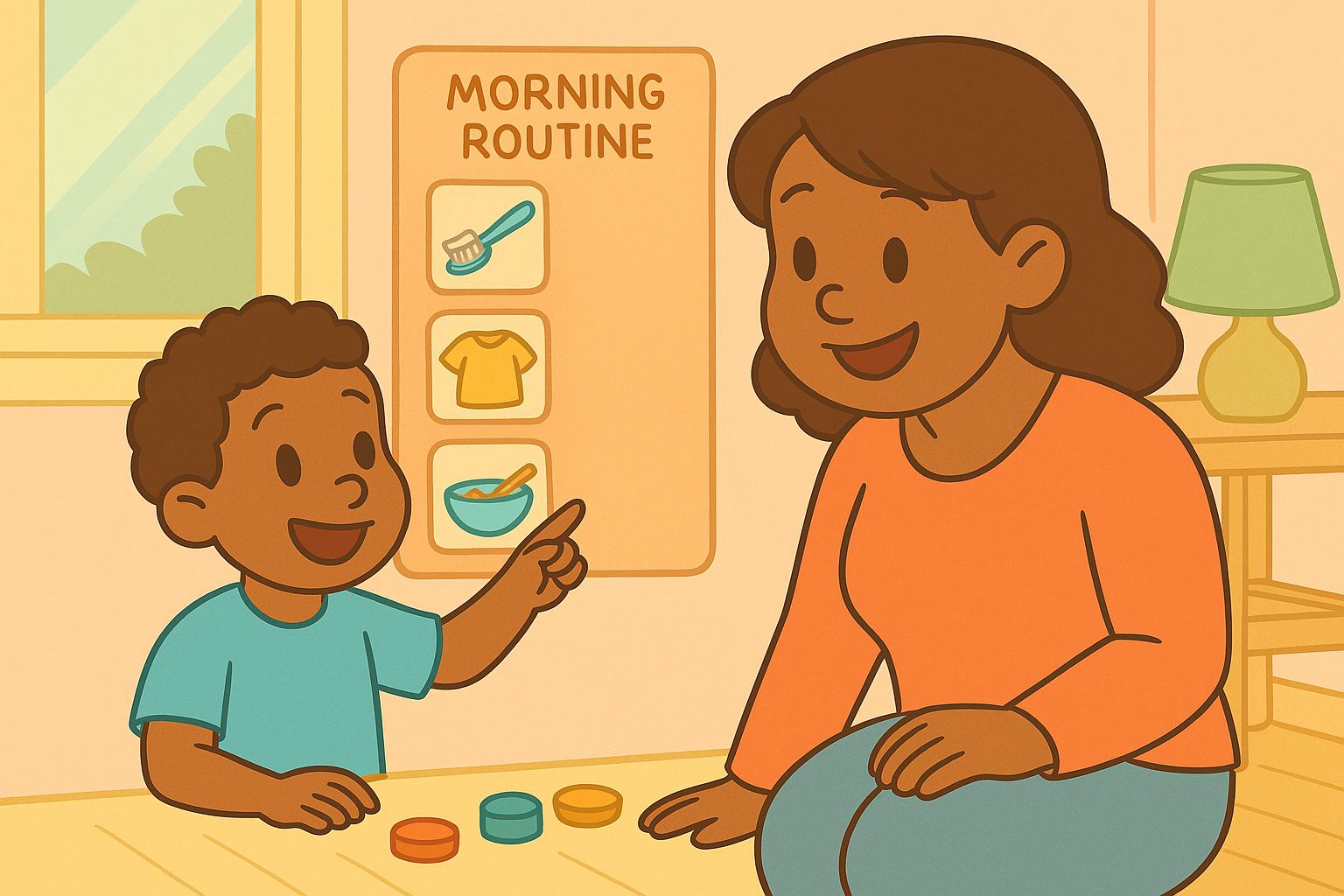How to Use Routines to Reinforce Learning Concepts
How to Use Routines to Reinforce Learning Concepts
Why Routines Matter for Learning
Routines aren’t just about keeping the day running smoothly. They also:
reduce stress and anxiety,
strengthen memory,
support attention,
boost independence,
help children predict what comes next,
create repeated opportunities to practice skills.
When learning happens at the same time, in the same way, through repetition — concepts stick.
The Science: Repetition Builds Neural Pathways
Young brains strengthen connections through:
patterns,
repetition,
sequencing,
consistency.
This is exactly what routines provide.
Each time your child repeats a routine, they’re building automaticity, freeing cognitive space for new learning.
Step 1: Pair Routines With Vocabulary
Anchor words to everyday rituals:
Morning:
“First shoes, then backpack, then out the door!”
Snack time:
“How many apple slices do you have?”
Bath time:
“Is the sponge above or below the faucet?”
Vocabulary makes meaning real.
(Try this too: Teaching Directional Words Through Movement)
Step 2: Use Songs to Mark Sequence
Songs + routines = memory magic.
A short tune can:
calm stress,
cue transitions,
reinforce order,
regulate attention.
Example:
🎵 “Brush-brush-brush, then rinse-rinse-rinse!”
Melody is a memory superpower.
(Related read: Teaching Time Concepts Through Songs and Routines)
Step 3: Build Counting Into Daily Routines
Math hides everywhere:
Count steps to the car.
Count jumps before cleanup.
Count crackers on the plate.
Keep it playful and quick — that’s all the brain needs.
(Try this too: Using Puppets to Teach Counting and Colors)
Step 4: Use Visual Schedules as Learning Tools
Picture schedules help children:
anticipate what’s next,
follow multi-step tasks,
feel ownership of the routine.
Add icons for:
play,
snack,
rest,
outside time.
Point to each as you go — this mirrors sequencing in reading!
Step 5: Reinforce Language Concepts During Cleanup
Cleanup is loaded with learning potential:
Ask:
“Where does the blue block go?”
OR
“Let’s sort animals on the shelf and vehicles in the basket.”
Classification + direction + vocabulary = win.
Step 6: Connect Emotions to Daily Moments
Add emotional vocabulary:
Morning rush:
“You’re feeling rushed.”
Bedtime:
“Your body feels tired.”
This strengthens emotional regulation — a key school readiness skill.
(Related read: The Power of Naming Emotions in Early Learning)
Step 7: Build Literacy Into Bedtime
Try:
reading the same book for 3 nights,
pointing to repeated words,
retelling yesterday’s section before reading today’s.
This deepens comprehension without worksheets.
Step 8: Practice Sequencing With Snack Prep
Snack routines are sequencing gold:
Wash hands.
Pick plate.
Choose snack.
Sit at table.
Narrate it aloud to reinforce “first, next, then, last.”
(Related read: Helping Kids Retell Events in Order)
Step 9: Use Puppets During Transitions
Puppet helpers can:
model behavior,
narrate steps,
ask playful questions.
For example:
“Mr. Dino forgot what comes next! Can you help?”
Puppets lower pressure and increase motivation.
(Try this too: How to Use Props and Puppets to Teach Concepts)
Step 10: Build Independence With Micro-Choices
Choices within routines encourage ownership:
“Do you want to brush teeth before or after pajamas?”
“Stickers or stamps after cleanup?”
Autonomy = long-term motivation.
What NOT to Do (Gently)
Avoid:
🚫 over-explaining every concept
🚫 lecturing during stressful transitions
🚫 forcing attention when dysregulated
Instead:
keep it short,
keep it playful,
keep it predictable.
When Routines Start Feeling Boring
Add variation:
new cleanup songs,
different counting challenges,
silly voices during reading.
Small novelty refreshes the brain.
When Routines Get Disrupted (Totally Normal)
Vacations, holidays, visitors — everything shifts sometimes.
Anchor back to:
one predictable bedtime step,
one predictable morning cue,
one predictable snack ritual.
Consistency doesn’t mean perfection — it means return.
Bringing It All Together
Routines teach:
✔ sequencing
✔ vocabulary
✔ early math
✔ emotional regulation
✔ independence
✔ executive function
When learning integrates into everyday life, it becomes effortless.
Your routines create:
confidence,
predictability,
mastery.
That’s school readiness at its core.
Fuzzigram’s Favorite Routine-Based Learning Ideas
✅ “Count jumps before snack”
✅ “Color sort toys during cleanup”
✅ “Sequence the bedtime steps”
✅ “Retell the morning routine”
✅ “Match the visual schedule cards”
This content is for educational purposes and is not a substitute for professional medical or psychological advice.
Popular Parenting Articles




